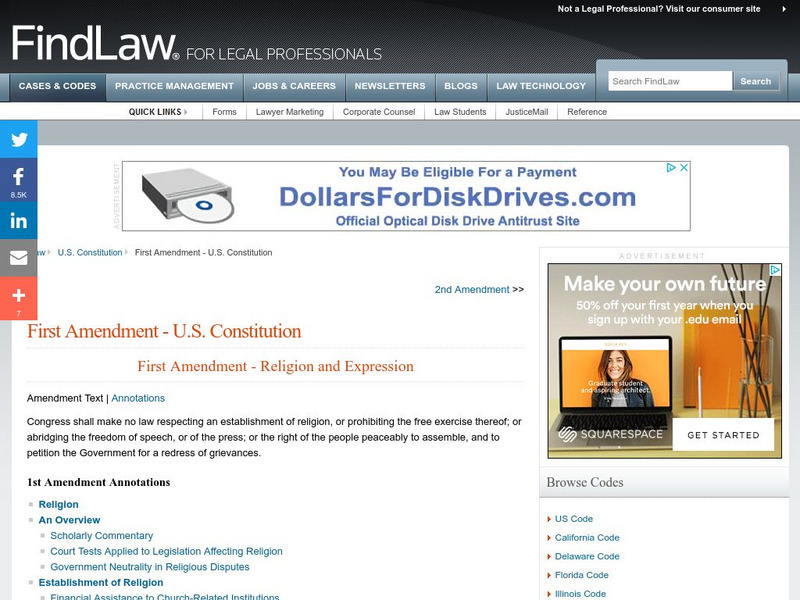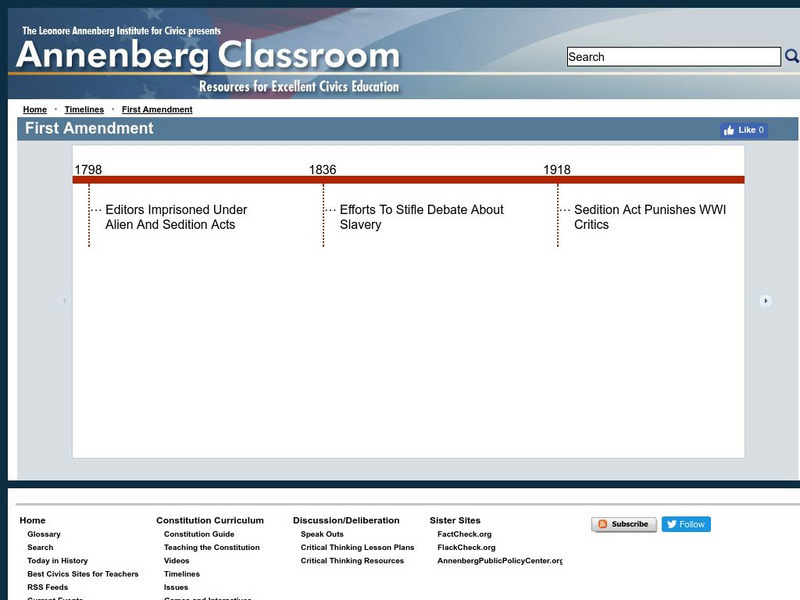Hi, what do you want to do?
Curated OER
Women in Baseball:Talk Show
Students explore the development of women's baseball during the 20th century. They "role play" women who participated in some form of baseball (amateur, semi-professional, or professional) as well as other advocates of women's sports as...
Curated OER
Gov. Reubin Askew's Stand on Busing And Integration in Florida Schools
Students research a straw vote placed on a Florida ballet in 1972 that asked if voters were in favor of prohibiting forced busing to further desegregation. They read primary documents, complete a worksheet and participate in class...
Curated OER
Dealing with Growth and Change
Learners discuss the right and wrong actions of a young Navajo boy. Using that information, they compare and contrast his culture to their own. In groups, they create a newspaper or poster showing the cultural contributions of the...
C3 Teachers
C3 Teachers: Inquiries: First Amendment
A learning module on the First Amendment. It includes several supporting questions accompanied by formative tasks and source materials, followed by a summative performance task. Students explore how the First Amendment applies in the...
US National Archives
National Archives: The First Amendment
Learners will look at documents and cases throughout American history to understand the effects of the First Amendment on our nation.
Reporters Committee for Freedom of the Press
Rcfp: First Amendment Handbook: Freedom of the Press
Very informative page focusing on the guidelines for freedom of the press, the first amendment. Offers examples and tenets to follow. Geared towards professionals but also accessible to students.
Other
Freedom Forum: Lesson Plans for the First Amendment
These lessons address constitutional principles and contemporary issues involving the First Amendment. They intend to have explore how freedoms began and how they operate in today's world. Students will discuss just how far individual...
Thomson Reuters
Find Law: u.s. Constitution: First Amendment Protections
This resource contains an annotated look at the different topics covered within the First Amendment of the U.S. Constitution. Click on any subtopic link for in-depth information about that part of the First Amendment.
Annenberg Foundation
Annenberg Classroom: First Amendment
Annenberg Classroom summary and text of the 1st Amendment to the Constitution. Links to relevant news articles, video, and timeline.
Other
First Amendment Center
This First Amendment site, partly news and partly background, contains information related to all the aspects of the freedoms outlined in the First Amendment.
Other
Us Courts: First Amendment Activities
Activities for students that make learning about the 1st Amendment relevant by applying landmark Supreme Court cases to contemporary scenarios related to the five parts of the First Amendment and rights to freedom of religion, speech,...
Annenberg Foundation
Annenberg Classroom: First Amendment
Check out this interactive timeline on first amendment of the United States Constitution.
US National Archives
Docsteach: The First Amendment
In this activity students will analyze documents that span the course of American history to determine their connection to the different phrases found within the First Amendment of the U.S. Constitution.
Annenberg Foundation
Annenberg Classroom: Eighteenth and Twenty First Amendments Timeline
A timeline that documents the history of prohibition and its repeal in the United States. Each entry links to more information.
Annenberg Foundation
Annenberg Classroom: Twenty First Amendment
Actual text of the 21st Amendment along with an explanation of its meaning. Part of the Annenberg Classroom Civics Education. Links to related resources.
Other
Lesson Plans for Teaching the First Amendment
This FreedomForum.org site lists the three English documents that were precursors to the American Bill of Rights.
Other
First Amendment Center: Freedom Forum, Newseum
This First Amendment Center "newseum" offers dozens of reports, articles, papers, and pages collected by the Freedom Forum. Includes today's news as well as archives.
National Endowment for the Humanities
Neh: Edsit Ement: The First Amendment
This resource presents lessons on the First Amendment. It contains many resources for use with children, and links to primary source documents.
Other
Freedom Forum: First Amendment Struggles & Triumphs
Find out how the First Amendment serves citizens in real life by reading about Daniel Ellsberg, Mary Beth Tinker, and Alton T. Lemon, all of whom were principal litigants in landmark Supreme Court cases regarding the freedom of expression.
University of Florida
Freedom of Speech: The First Amendment and the u.s. Constitution
Interactive site outlines thoughts on the First Amendment from four founding fathers. Click on their faces to find an index reflecting their thoughts. From a student project at University of Florida.
Other
Fac: Curfews, Loitering, and Freedom of Association
This detailed article offers a well-documented overview of this constitutional freedom, as well as an FAQ section and additional cases and resources focused specifically on this aspect of the First Amendment. (Published Sept. 16, 2002 /...
Other
Libraries & First Amendment: Banned Books
This overview of censorship in the United States cites Supreme Court decisions and links to a number of other resources. (Date of Article: Sept. 13, 2002)
Other
First Amendment Schools: Lesson Plans: Religious Liberty
A series of lessons examining freedom of religion. A few of the lessons are off-site and the links no longer work.
Thomson Reuters
Find Law: U S. Constitution: Annotation 18: First Amendment
Information about the boundaries of seditious speech and the permissibility of governmental measures which are directly concerned with the content of expression.
Other popular searches
- First Amendment Debate
- First Amendment Court Cases
- First Amendment Rights
- First Amendment and Schools
- The First Amendment
- Reading First Amendment
- First Amendment and Students
- Free Speech First Amendment
- First Amendment Outline
- Powerpoint First Amendment
- Free Speech +First Amendment
- First Amendment Journalists
























